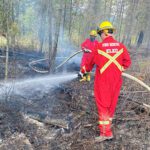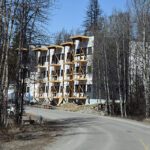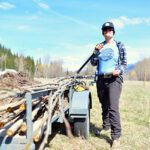Home »

KNC asking feds for EA review of Tent Mountain re-start
 The Ktunaxa Nation Council (KNC) has sent a letter to the federal government requesting a federal environmental impact assessment for the proposed re-start of an open-cut coal mine 26 km south of Crowsnest Pass.
The Ktunaxa Nation Council (KNC) has sent a letter to the federal government requesting a federal environmental impact assessment for the proposed re-start of an open-cut coal mine 26 km south of Crowsnest Pass.
In an April 1 letter to Jonathan Wilkinson, Minister of Environment and Climate Change and Greg Bosse, Project Manager, Prairie and Northern Region Impact Assessment Agency of Canada, the Ktunaxa Nation asks that Montem Resources’ Tent Mountain Project undergo a review under section 9(1) of the Impact Assessment Act (the Act).
According to Montem’s website, the Tent Mountain Mine straddles both sides of the southwest Alberta and southeast British Columbia border. It has current mine permits in both Alberta and British Columbia covering steelmaking coal reserves, and the company is working with regulators to obtain mining licences to enable the re-start of open-cut mining.

The Australian company purchased the mine in 2016 and “has since conducted several drilling campaigns as well as two years of environmental monitoring at Tent Mountain. In early-2020, Montem completed a Definitive Feasibility Study, which showed strong economic results, including a mine life of more than 14 years.”
The KNC letter notes it supports a similar request made by the Siksika and Blood Tribe/Kainai Nations of Alberta on March 2.
“In summary, the KNC is requesting that the proposed project be designated because of the project’s potential to cause or contribute to significant adverse impacts on matters within federal jurisdiction, and its impact on Ktunaxa Aboriginal rights and traditional practices,” the KNC stated.
“The location of the proposed project is in an area that is of importance to the Ktunaxa Nation, where the Nation has Indigenous rights and interests that are recognized and affirmed by the Constitution Act, 1982, and where Ktunaxa citizens are engaged in the ongoing practice of Ktunaxa rights through use of the lands and resources. Due to the location, size and lifespan of the proposed project, the KNC considers that it will likely cause significant adverse impacts on the Ktunaxa Nation’s Indigenous rights and interests,” the KNC letter, signed by Vickie Thomas, KNC Director of Lands and Resources.
“The need for a Federal EA to address potential impacts to Ktunaxa rights and interests is underscored by the failure of the Alberta Aboriginal Consultation Office (ACO) to consult with the KNC regarding past major coal mine approvals.
“During the course of the joint panel review (JRP) of the Grassy Mountain Coal Mine, the ACO – which is responsible for all aspects of aboriginal consultation regarding energy and mining projects within provincial jurisdiction – failed to engage in any consultation with the KNC, notwithstanding the KNC’s full participation in the panel review.
“This omission indicates that the ACO cannot be relied upon to fulfill the Crown’s constitutional duty to consult with and accommodate the Ktunaxa Nation regarding the Tent Mountain Project. A Federal EA is required to ensure the Crown’s duties, and the purposes and intent of the Impact Assessment Act, are fulfilled.
“In addition, the project will likely have impacts to four additional areas of Federal jurisdiction: regional and transboundary cumulative effects, fisheries, migratory birds and endangered species. As such, the KNC considers it important that Canada become fully engaged in the review and assessment of the Project by designating it as reviewable under the Act.”
According to Montem Resources literature, approximately 200 temporary jobs will be created during construction, with an additional approximately 190 full-time jobs created, across a range of skill sets, during mining operations, over an expected mine life of 14 years. The open pit mine, with truck/shovel convention, will cover 750 ha in size.
The area was originally mined from 1948 to 1983 with reclamation occurring on parts of the property.
“However, poorly described in the project summary document is that the project also crosses over the southeastern B.C. border and into Qukin ʔamakʔis (Raven’s Land), also known as the Elk Valley, and will have impacts within B.C. and downstream into Montana,” the KNC point out.
“The project requires a BC Mines Act permit, and the project loading area will be located in B.C. as well as the presence of potential waste rock dumps which stretch across the Alberta border and into B.C. Of particular concern to the KNC, the project includes a settling pond which discharges into Michel Creek, which is a fourth order tributary of the Elk River. The project requires a B.C. Environmental Management Act permit for discharge of waste into B.C. waters, and contaminants from the project will contribute to already excessive contaminant loading in the Elk River and downstream to the transboundary Koocanusa reservoir,” the KNC letter outlines.
The project area is bounded by Teck Coal’s Coal Mountain Operations (which is entering the care and maintenance phase) to the southeast, the active Teck Coal Elkview Operations to the northwest, with two proposed mining operations – North Coal’s Michel Coal Project directly adjacent to the project, and NWP’s Crown Mountain Project to the north.
“The potential for the project to contribute to regional cumulative effects is therefore also a deep concern,” the KNC added.
The letter says the project has potential to result in the loss of opportunity to carry out cultural practices, including teaching, traditional use and harvesting activities, including fishing, hunting and gathering, in both the project area and the surrounding area where project effects may occur, including impacts to water quality due to development of the project.
There would also be loss of access to, and sensory disturbance impacting, preferred places, preferred species and resources, and preferred practices central to Ktunaxa use, language and identity and a loss of Ktunaxa cultural, historical and archaeological sites due to land disturbance associated with mine development, KNC stated.
Map from Montem Resources’ website
e-KNOW







